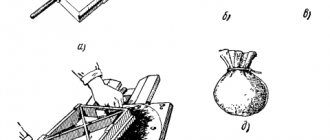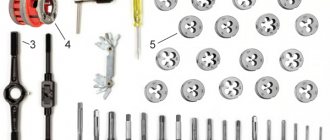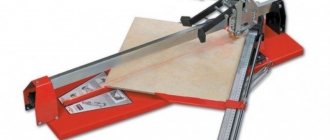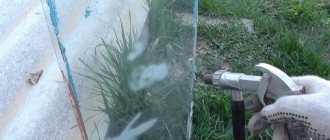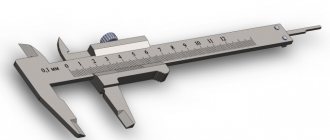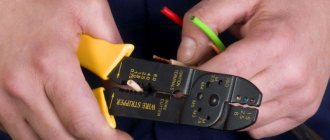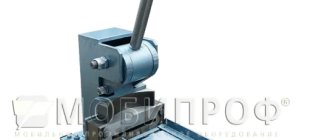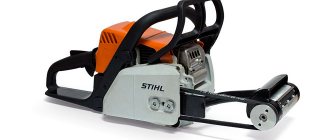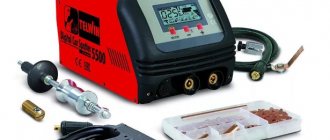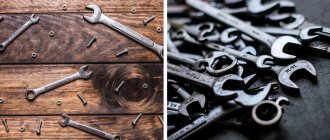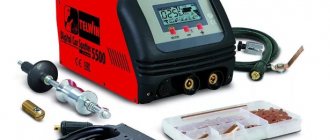The scraper is well known to plumbing experts. Using this tool for surface finishing, metal parts can be given a minimum degree of roughness, and their geometric parameters can be given a high degree of accuracy.
Scraping the lathe tailstock guides
How is scraping done?
The word “scraping” itself, which can be translated as “scraping”, came to us from Germany. It very accurately corresponds to the essence of the technological operation that it denotes. During this operation, irregularities are scraped off the surface of the part, which makes it as smooth as possible.
The scrapers used to perform this operation are made of tool steel. The design of this tool consists of a four- or triangular-shaped handle and a cutting part. To give the working part of the scraper the required degree of hardness (64–66 HRC units), it is subjected to hardening.
Doctors are made mainly of standard length (20–40 cm), and the width of their cutting edge depends on the type of operation being performed. Thus, rough scraping is performed with a tool whose working part width is 20–30 mm; for finishing scraping, this interval is 15–20 mm.
The type of scraping performed also influences the angle of the tip that should be formed on the tool. Plumbing experts recommend using the following sharpening angles for the cutting tip:
- 75–90° – for roughing;
- 90° – for finishing scraping;
- 90–100° – for finishing operations.
It should be borne in mind that the sharpening angle of the cutting edge of the scraper is measured relative to its axis.
Sharpening depends on the shape of the working part of the scraper
The geometric parameters of the tool for scraping are not regulated by any GOST, although many, out of ignorance, try to find such data in the standard under number 1465-80. Meanwhile, GOST 1465-80 refers to files and has nothing to do with scrapers. As for the scrapers themselves, in the relevant GOSTs one can find only the requirements for the metal for their manufacture, as well as for the rules for accepting such a tool belonging to the metalworking group.
Secrets of caring for files
Like any other hand tool, the hog file should be looked after in a timely manner, thereby significantly extending its service life. Despite the use of metal, the bastard file is very fragile. The main recommendations are the following:
- Hitting metal objects is not allowed. This rule must be observed at the time of work and storage. Most often, damage occurs when all the tools are dumped into one box. The ideal choice is to use a special box with various slots, which are designed to store individual tools.
- Experts prohibit placing a garnish file on a metal surface. This is due to the fact that in such a case you can lose some of the teeth. If work is carried out frequently, then you need to prepare a special wooden stand in advance. This material is softer and suitable for this application.
- The product should be stored away from high humidity. This is due to the fact that moisture causes corrosion, which significantly reduces the service life.
- Do not allow the product to come into contact with any lubricants. Some people lubricate the surface to eliminate the possibility of corrosion, but this is a serious mistake. Removal of metal from a surface is accomplished by friction, and lubrication reduces efficiency.
- It is not recommended to carry out work involving removing scale with a file. This is due to the fact that the special properties of the metal cause the grooves to quickly become dull. If there is no other tool at hand, then it is recommended to choose an old draper file.
- The service life of the product in question can be significantly increased due to its first use in the processing of soft materials. Only after this they begin to work with hard alloys. In addition, you cannot use a hog file to work with materials for which it is not intended.
- If a tool is purchased for processing soft alloys, it is recommended to cover the working surface with chalk. This eliminates the possibility of chips sticking. This problem often causes a significant decrease in the effectiveness of the treatment. If you do not take any action before actually performing the work, then cleaning the chips afterwards will be very difficult, especially when working with soft alloys.
- A situation often occurs when the surface of a hog file is covered with a large amount of oil. This problem can be solved by cleaning the surface with charcoal.
https://youtube.com/watch?v=-rWxWfg12Uc
Compliance with a relatively small number of recommendations can significantly extend the service life of a wormwood file. It is worth considering that even a minor defect can significantly reduce the service life.
Types of tools for scraping
Today, specialists use various types of scrapers, differing from each other in several parameters. One of these parameters is the shape of the cutting part of the tool, depending on which scrapers are divided into flat, triangular and shaped. Unlike flat and triangular type tools, shaped scrapers have a working part that completely follows the shape of the surface of the workpiece.
Scrapers with various working parts
Triangular scraper with wooden handle
A tool, the working part of which has several edges, mainly processes cylindrical and concave surfaces, and flat scrapers successfully cope with the processing of various grooves and grooves. In practice, disc and ring-shaped scrapers are often used. With the help of the former, parts with wide surfaces are processed, and the latter are used for scraping products that have a round shape.
According to their design, scrapers can be one-piece or dismountable, single- or double-sided. More durable are double-sided scrapers, which differ from single-sided scrapers in that they have two working parts located on both sides of the handle.
Composite scraper device
The working part of the scraping tool, according to its location relative to the handle, can be flat or curved. Scrapers, the working part of which has a curved shape, are most conveniently used for processing soft metals, as well as parts with sharp corners.
Relatively recently, only hand scrapers were used in plumbing, but today many manufacturers offer tools equipped with a pneumatic or electric drive. You still have to manipulate such a tool manually, but this requires much less effort than when using a hand scraper.
Universal scraper BIAX
How to sharpen a knife with a file
It is better to use specialized products for sharpening knives.
But if you only have a file at hand, you can put it to work - after using the whetstone, the knife will “work” quite tolerably.
Finely notched bars are suitable for work.
In any case, you will have to work roughly - even velvet files are far from the relief of fine-grained sharpening stones.
Such sharpening is good when the cutting edge of the knife is very dull - the difference “before and after” will be clearly visible.
But if a better result is needed, you need to use the block together with musat - a kind of file.
In this case, they work with a block in a rough format, and with a musket they finish the edge to perfection.
As for the file sharpening technology, it is similar to the process on a whetstone.
The average angle of the knife blade relative to the tool is 30 degrees.
Areas of application for scrapers
Using a scraper, a specialist removes the thinnest layer of metal from the workpiece, the thickness of which can vary between 0.005–0.7 mm, which allows the degree of surface roughness to be brought to the required level. With the help of such a technological operation, parts are often processed that will subsequently mate and move relative to each other. The most common parts for finishing which various types of scrapers are used are:
- parts of machine tools and high-precision instruments;
- elements of sliding bearings;
- various measuring instruments and devices for carrying out control operations;
- blades of cutting tools (to sharpen them, a so-called sharpener-scraper is used).
Scraping - finishing the lathe slide guides
One of the advantages of scrapers is their versatility, so their scope of application is not limited to the above points. Using such tools, they perform engraving work on the surface of soft materials, process the edges of parts, and remove old coating. They have also found application in cosmetology; manicurists use them to perform their manipulations.
The scrapers used to solve various problems can be distinguished from each other even by photos, since they have different designs and geometric parameters. Thus, a miniature manicure tool is made in the form of a spatula with a comfortable handle, and devices for scraping large workpieces can be produced in the form of carbide plates. It is quite difficult for a non-specialist to guess that such a plate is a scraper, even if he sees it in person and not in a photo. To use this tool, you need a special lock, equipped with a comfortable handle for performing metalwork manipulations.
The scraping technology depends both on the size and configuration of the workpiece, and on the hardness of the material from which it is made. A specialist who is going to perform such a technological operation must correctly select the sharpening angle of the working end part of the scraper relative to its axis. When processing different materials, this angle must be within the following limits:
- when scraping soft metals – 35–400;
- when processing the surfaces of steel parts – 75–900;
- when performing scraping of parts made of cast iron and bronze - more than 900.
This file is not suitable for manicure
I remember this well from my school years, when we took plumbing. We were given details and tasks. It was necessary to bring the workpieces to a certain size, using measuring instruments to find out how much the part should “lose weight”. And most importantly, name and choose the instrument correctly. One girl was skipping work and came and didn’t understand anything. The teacher asked her if she lost her manicure set, could she use a file? She answered: “Yes,” he said: “Well, try it,” and he gave her the largest file, half a meter long, she could barely hold it in her hands.
Every craftsman knows perfectly well the whole range of these simple, one might say old-fashioned, but necessary tools - files. They are especially often used when working with metal, in the garage or country house, or when renovating an apartment. Fitting parts to size, removing rust, scale, burrs, and finally grinding to a mirror finish - we perform all these operations using files.
Types of file cuts
According to the number of notches, machinist's files are divided into six numbers: 0, 1, 2, 3, 4, 5. The notch number is an indicator of the operational purpose of the size range of files based on the pitch of the main notch.
Files with notches No. 0 and 1, the so-called bastard files, have the largest teeth and are used for filing with an accuracy of 0.2-0.5 mm parts that have a processing allowance of 0.5 to 1 mm.
Files with a notch No. 2, the so-called personal ones, are used for finishing filing of parts with an accuracy of 0.02-0.15 mm, while the processing allowance ranges from 0.1 to 0.3 mm.
Files with notches No. 3, 4, 5, so-called velvet, are used for final finishing of parts with an accuracy of 0.01 to 0.005 mm, while the processing allowance ranges from 0.025 to 0.05 mm.
Files are made from tool carbon steel U13 or U13A and are hardened to a hardness of at least HRC 54-58.
Rasps differ from metalworker's files in their notch; their teeth are large and short in the form of pyramids. Thanks to the large tooth sizes and spacious grooves behind each tooth, rasps are suitable for filing soft metals. The rasp teeth are arranged in rows perpendicular to its axis. To prevent grooves when filing, the rows are shifted relative to each other by half the pitch between the teeth.
In coppersmithing and tinsmithing, general-purpose rasps (GOST 6876-54) are used for filing parts made of soft metals (aluminum, duralumin, etc.). General purpose rasps are made in four types: flat blunt-nosed, flat pointed-nosed, round and semicircular. Rasps of all four types are manufactured in lengths of 250 and 350 mm.
For the manufacture of rasps, tool carbon steel is used, mainly grades U7A, U10A, hardened to a hardness of HRC 35-40.
The smallest files, the so-called needle files, are designed to perform very fine and precise work. They differ in cross-sectional shape and in the number of notches per centimeter of file length.
Needles (GOST 1513-67) are manufactured according to the cross-sectional shape of eleven types: flat blunt-nosed, flat pointed-nosed, square, triangular, triangular one-sided, round, semicircular, oval, rhombic, hacksaw and grooved.
According to the number of notches, needle files are divided into six numbers: 1, 2, 3, 4, 5, 6.
Flat blunt-nosed, flat pointed-nosed, square, triangular, round, semicircular, rhombic, and grooved needle files are made in two sizes: the length of the working part is 60 and 80 mm and the length of the shank is 60 and 80 mm, respectively.
Single-sided triangular and oval needle files are made in three sizes: the length of the working part is 40, 60, 80 mm and the length of the shank is 80, 60, 80 mm, respectively.
Hacksaw files are manufactured in three sizes: the length of the working part is 60, 80, 40 mm and the length of the shank is 60, 80, 80 mm, respectively.
The needle files are made from tool carbon steel U12 or U12A and are hardened to a hardness of HRC 54-60.
The file has a wooden handle with a tightening ring, which protects it from cracks when placed on the file shank. The handle must fit tightly onto the file shank, for which a hole is drilled in it with a diameter corresponding to the size of the middle part of the shank and a depth equal to the length of the shank. Then, using a red-hot shank of an old file of the same size, burn out a hole exactly in the shape of the shank at 2/3-3/4 of its length. When putting the handle on the shank, do not hit the file with a hammer, as the cutting part may break. When put on correctly, hit the handle on a bench until it fits snugly on the shank. When inserting the handle onto the file shank, make sure that it is inserted without distortion.
Handles are made of wood (birch, beech) or pressed paper. Wooden handles are used more often as they are more practical. The length of the handle should be one and a half times longer than the file shank.
Handles for general purpose files are made in lengths of 90, 100, 110, 120, 130, 140 mm, with a diameter at the end of 12, 16, 20, 23, 25, 28 mm, respectively. The size of the handle is selected according to the size of the file.
https://100metrov.com.ua/images/napilnikiraznue5.jpg
At the same time, files are widely used in various fields. They are used for processing parts made of wood, metal and other materials. They are used for sharpening chains or saw blades. They are useful when installing and assembling various structures.
Thus, the value and necessity of the file as a tool is beyond doubt. That is why we will try to decide how to choose a suitable copy.
Tool steels for making files
While studying the properties of steel, we noticed that at a certain carbon content it becomes possible to obtain high hardness using special heat treatment. The low carbon content does not allow hardening, which increases the strength properties of the metal.
Only at a concentration of 0.8% and above do the properties of the Fe-FeC₃ alloy change (the properties are studied in a special course in metal technology, called “Materials Science”). Annealed steel is quite ductile and can be processed on metal-cutting machines. There is a condition in which high plasticity is noted. It is called austenite. Achieved at a temperature of 727 ⁰C and above.
Only hypereutectoid steels can be quenched and tempered. If there are no other additives, then they are usually designated as U8...U13. The letter “U” characterizes carbon steel, and the number indicates the carbon content in hundredths of a percent.
Attention! To carry out hardening, it is necessary to heat the steel part to the austenite temperature and above. It can be easily identified using a magnet
When the desired value is reached, the magnetic properties completely disappear when heated.
Some people believe that heating to the appropriate temperature is enough. When heated, the thermal conductivity of the metal decreases sharply. Within one minute, parts weighing about 1 kg are heated to a depth of 0.10...0.13 mm.
Important! To harden the surface to a depth of 1.5...2.5 mm, you will need to hold it at the desired temperature for at least 15...20 minutes. Less deep hardening may result in the measuring cone on the Rockwell instrument falling through a thin layer of hardened metal.
The result will be disappointing.
Hardening is carried out in water, air and mineral oil. A high cooling rate promotes deeper hardening of the metal. When making cutting tools, they are hardened in oil. Steel cooling occurs at a rate of 400…450 ⁰/sec.
After hardening, the parts acquire a certain fragility. Therefore, to relieve internal stresses, low tempering is performed. It occurs at a temperature of 180...250 ⁰С. The part is placed in muffle furnaces heated to a given temperature. Keep in them for at least 30...40 minutes. Then they allow it to cool slowly.
In practice, heat treatment of file metal occurs in the following sequence:
- The workpiece is heated to a temperature of 900…920 ⁰С (the higher value is explained by the fact that less time is required for internal heating of the metal).
- Maintain in a heated state for 15...20 minutes.
- It is hardened in mineral oil (it is allowed to use waste from internal combustion engines).
- Hardness testing is carried out, and with proper heating and cooling, hardened trostite (HRC 54...58) is obtained.
- The workpiece is placed in a muffle furnace at a temperature of 200…210 ⁰С.
- Leave for 30...40 minutes and take out.
- It cools down in air (temperature 18...22 ⁰С) on its own.
- The hardness is checked; for tempered trostite (the state of hardened and tempered metal), the hardness increases by 2...4 units.
To increase the strength and hardness of steels, alloying elements are added during welding. They make it possible to improve performance characteristics and obtain metal with desired properties.
